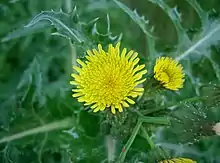| Sonchus asper | |
|---|---|
 | |
| Scientific classification | |
| Kingdom: | Plantae |
| Clade: | Tracheophytes |
| Clade: | Angiosperms |
| Clade: | Eudicots |
| Clade: | Asterids |
| Order: | Asterales |
| Family: | Asteraceae |
| Genus: | Sonchus |
| Species: | S. asper |
| Binomial name | |
| Sonchus asper (L.) Hill 1769 | |
| Synonyms[1] | |
|
Synonymy
| |
Sonchus asper, the prickly sow-thistle,[2] rough milk thistle,[3] spiny sowthistle,[4] sharp-fringed sow thistle, or spiny-leaved sow thistle, is a widespread flowering plant in the tribe Cichorieae within the family Asteraceae.
Description
Sonchus asper is an annual or biennial herb sometimes reaching a height of 200 centimetres (6.6 ft) with spiny leaves and yellow flowers resembling those of the dandelion. The leaves are bluish-green, simple, lanceolate, with wavy and sometimes lobed margins, covered in spines on both the margins and beneath. The base of the leaf surrounds the stem. The leaves and stems emit a milky sap when cut. One plant will produce several flat-topped arrays of flower heads, each head containing numerous yellow ray flowers but no disc flowers.[5][6]
Distribution
Sonchus asper is native to Europe, North Africa, and western Asia. It has also become naturalized on other continents and is regarded as a noxious, invasive weed in many places. Its edible leaves make a palatable and nutritious leaf vegetable.[7][8][9][10][11]
It is found in cultivated soil, pastures, roadsides, edges of yards, vacant lots, construction sites, waste areas and in grasslands.[12]
References
- ↑ The Plant List, Sonchus asper (L.) Hill
- ↑ BSBI List 2007 (xls). Botanical Society of Britain and Ireland. Archived from the original (xls) on 2015-06-26. Retrieved 2014-10-17.
- ↑ USDA GRIN Taxonomy
- ↑ USDA, NRCS (n.d.). "Sonchus asper". The PLANTS Database (plants.usda.gov). Greensboro, North Carolina: National Plant Data Team. Retrieved 19 November 2015.
- ↑ Flora of North America, Sonchus asper (Linnaeus) Hill, 1769. Spiny-leaf sow-thistle, laiteron rude
- ↑ Flora of China, Sonchus asper (Linnaeus) Hill, 1769. 花叶滇苦菜 hua ye dian ku cai
- ↑ Altervista Flora Italiana, Sonchus asper (L.) Hill includes photos and European distribution map
- ↑ De la Barra, N. 1997. Reconstrucción y Evolución del Paisaje Vegetal Autóctono de la Zona Urbana y Peri-urbana de la Ciudad de Cochabamba i–v, 1–174. Tesis, Universidad Mayor San Simón, Cochabamba
- ↑ Marticorena, C. & M. Quezada. 1985. Catálogo de la Flora Vascular de Chile. Gayana, Botany 42: 1–157
- ↑ Humbert, H. 1923. Les Composées de Madagascar. Mémoires de la Société Linnéenne de Normandie 25: 1–335.
- ↑ Atlas of Living Australia
- ↑ Sonchus oleraceus L. by iewf.org
External links
- Spiny Sowthistle in Virginia Tech Weed Identification Guide
- WeedAlert.com's article on the Spiny Sowthistle
- photo of herbarium specimen at Missouri Botanical Garden, collected in Madagascar in 1932
 Media related to Sonchus asper at Wikimedia Commons
Media related to Sonchus asper at Wikimedia Commons